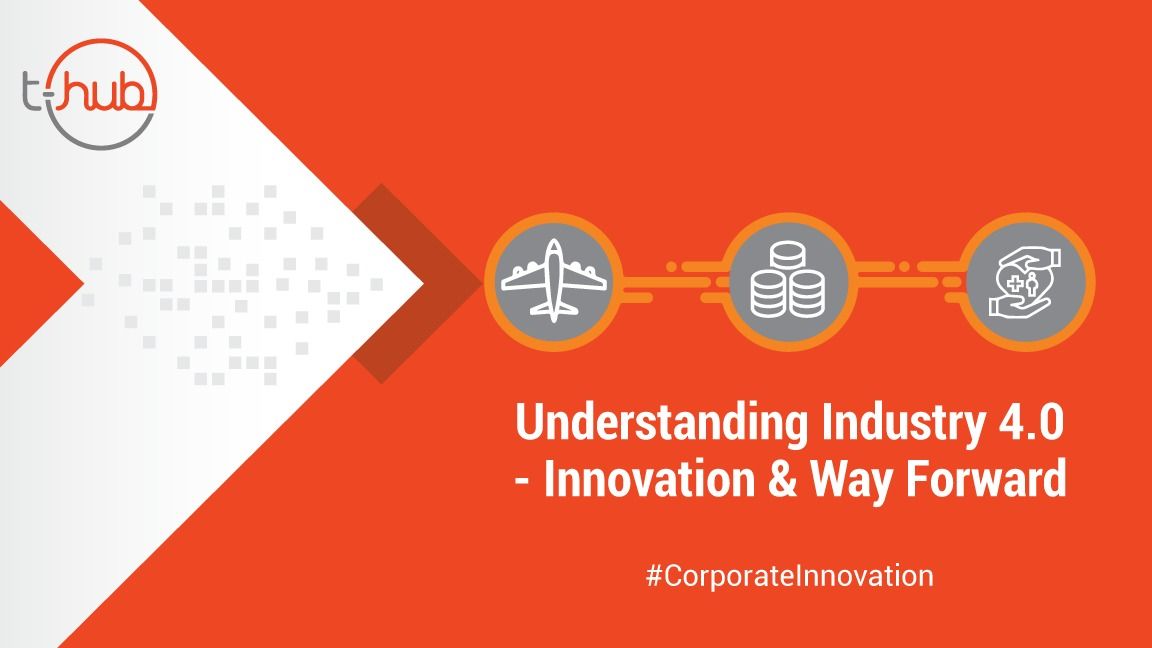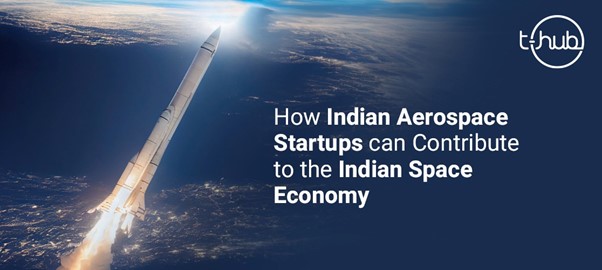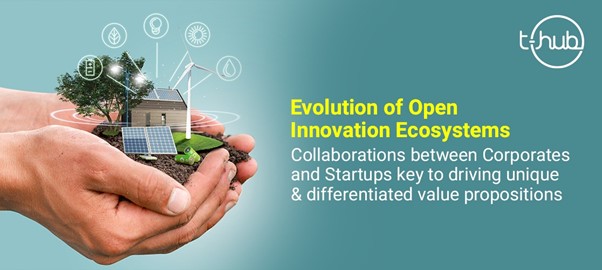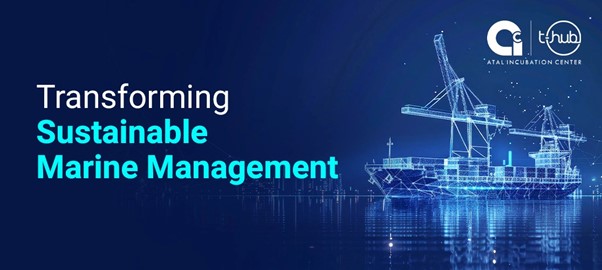“Automation and robotics provide the muscle for Industry 4.0, AR/VR, cameras and other sensors provide the senses, and data and connectivity are its central nervous system. But the real brains behind this industrial revolution is Artificial Intelligence.”
The fourth industrial revolution is the new way of combining traditional manufacturing practices with advanced smart technologies like analytics, cloud computing, machine learning and Internet of Things to predict and diagnose issues without much need of human intervention. We are looking at end to end optimization of manufacturing operations and value chain, not just improving production efficiency, but also to look at how we can take into account the manufacturing supply chain, customer behavior, and customer demands given that the fluctuations are high in the current situation.
The idea of this blog is to bring out some of the insights shared by industry experts during the recent Corporate Innovation roundtable anchored by T-Hub.
Current challenges in Industry 4.0
● Absorption of technology is more of an issue – For most of the key challenges that we are struggling with, solutions are available. Technology is less of an issue as it is moving at a faster pace for many of the core areas, but regulation and business models are the ones lagging behind. Therefore, absorption of technology is more of an issue right now.
● Safety, security, data biasness, and ethical issues are other major challenges being faced, which needs to be solved by bringing all the stakeholders together.
● The main challenges being faced by enterprises today are
- Investments in the past that have not yielded the expected results with their customers.
- Customer expectations are changing too fast and it is not just about delivering a product, but about delivering an experience. This would require a lot of change from the enterprise point of view as they would have to change the whole way of how customers consume and experience the products all through till the end.
● Change Management – Keeping the whole organization engaged is another challenge. The organization structure has to be re-configured now in the new digital world. It’s not just about technology, but customers are wanting to know how the manual processes when converted to digital look like.
● Big Data – When data harmonization or data convergence takes place, AI will be leveraged, owing to the type of data, complexities and linkages between them. This Big Data generated is the biggest challenge of Industry 4.0.
● The Aviation and aerospace sector is going through a huge unprecedented market change right now – aircrafts being grounded, many airlines filing for bankruptcies, job cuts, companies having to resort to cost cuttings etc.
● In the Agriculture sector, we have a lot of AI based solutions like crop identification, crop areas, yield prediction and linking it to the supply chain. Solutions are available for core issues that farmers and the government have been struggling with, but there is a huge gap in order to make them more production worthy in terms of business model or operational use.
● In the Health sector, AI can be useful in tele-medics and primary healthcare and we are also seeing the emergence of chat bots. Though technology and solutions are present and moving at a good pace, it is of paramount importance to combine and bring all other variables up to speed to create the right impact.
Startups – The forefront of disruptive technologies
Nowadays, corporates are exploring new disruptive technologies by setting up teams inside their organization or easier by leveraging startups which are at the forefront of harnessing these technologies to see what values they would bring. At the same time, it also brings out the challenges within big corporations while working with startups – like willingness for data sharing, having a data governance framework in place, data security etc. established in the organization. We need to try and overcome these hurdles and work with startups and see if it adds value to the operations. Working with startups around the world is a great way to source latest technologies and solutions. For example, in the OEM sector, startups are not only helping solve consumer issues, but also helping with improving the maturity of the softwares.
Born digital startups are built to scale from day one. The larger companies have abysmal records of internal innovation. They are looking for co-opting innovation which is becoming a more successful model now. In reality, for technology startups around industrial space, the scaling is still linear. Currently there is a possibility for a few parameters like productivity, quality, and supply chain visibility to happen sooner.
Corporates nowadays making a lot of strategic investments in startups is an indicator that they are serious about the whole process. For corporates to move ahead in the digital era, they need to partner with startups and align closely with them for acceleration. On the other hand, State governments are also using a lot of technology, and are far more open to working with established startups. Making this the main objective for the policy makers and enterprises, it would be the single biggest goal to achieve for India.
What are the challenges faced while adopting startup solutions?
- Production deployment readiness – Corporates have multi million dollar deals with SLAs signed up, financial liabilities and guarantees to give. When startups with good ideas and scalability are taken to these corporations, there is a need for a lot of interventions for production readiness in terms of real life deployment of the solution. This can become a hindrance many times. For every corporate, In their respective segments, there are very tight controls in terms of SLAs, commitments and penalties. So, by partnering with a startup, the liabilities that they have to bear are tremendous. Hence the best way out is to take in startups and carve out areas for them where there is requirement and guarantee in scaling and performance.
- Having the correct proposition to sell – Similarly, in the aerospace and aviation sector, while working with startups, companies realized that the startups do not have enough real life exposure and experience in this domain. In comparison of Indian startups with the ones abroad, it has been observed that we have better technology but there is a lag in knowing how to package the product exquisitely for sale. While trying to be innovative and disruptive, it is important for startups to not only focus on technology but also on packaging, marketing and propositions to sell.
- Documentation – In the case for any defense OEMs to work with startups, it is very crucial for the processes, NDAs, and agreements to be in place in order to create a safe platform that builds confidence for them to work with startups.
Adapting to the new normal
- In order to adapt to the new norm, five major areas of impact in the industrial sector being focused upon are-
1. Enhancing the productivity
2. Enhancing the quality
3. Enhancing the maintenance of infrastructure
4. Traceability and genealogy of where it came from
5. Energy
Productivity and quality are areas where there is a huge amount of purchase. This is where we are seeing the market react much faster than the rest. Before COVID and post COVID, the biggest difference is the adoption of digital measures. While looking at quick ROI, and faster ability to benefit from industrial IOT, productivity and quality tend to be the forerunners.
- Digitization – Most of the large companies are using this downtime as an opportunity to start using more digital initiatives, like leveraging cost benefits while planning their cost management, as well as making their operations and processes more productive and efficient.
When enterprises start thinking about creating a digital experience for their customers, they are working towards giving them a visibility of where the product currently is and when it can be delivered, how they can be maintained, serviced, replacements, future upgrades etc. In this way, all the facets in the value chain of an enterprise are touched – like manufacturing, supply chain,, sales and marketing, product development, R&D and aftermarket. The enterprises should try to achieve digital transformation in subtle incremental ways over a period of time.
- Internal Innovation Engines – Another booming trend is that large organizations and MNCs are treating their innovation engines as startups themselves. At an eclectic level, this is the first time that innovation is happening across Geos, time zones and segments at the same time. Companies are learning technologies at the same time as their customers. This changes the dynamics completely.
- Plug and play multiple startup solutions – The biggest challenge is not to have too many startups focused on point solutions, but instead have 3-4 startups come together along with a system integrator and make the whole process plug and play and replace the existing process with the new digital processes. This is a better way to expand and scale up because for every point solution, there are around 200 startups globally competing for the same space. So it is better to take the dependency of a few startups coming together to solve the larger problem and do it in a plug and play style.
- Shift of manufacturing base to India – We have various opportunities coming in – OEMs are shifting out from China to find a new destination for manufacturing due to the drastic effect of supply disruptions. It is agreed that Indian manufacturing ecosystem is not high tech in technology adoption, but is a good destination for expansion of services. With this, a lot of startups will get an opportunity for the first time to get into industries where the entry barriers are normally quite high. With the upcoming industrial parks, Pharma cities etc., we need to think of how we can be more attractive in terms of smart industrial clusters, what needs to be created from the infrastructure perspective, and create a foundation to enable overseas companies to establish their new base here.
Finally, if corporates have to scale industry 4.0 solutions by deploying large number of use cases, then –
- These use cases either need to be implemented by their own innovation engines and engineering teams across the organization.
- Or if they are engaging with multiple startups for implementation of these use cases, then it is important to have a strategy to ensure that these use cases are integrated leveraging a common platform/infrastructure/tools etc. Such strategy will help startups understand how to engage with corporates to make the implementations successful.
— Shanti Darisetty, Corporate Innovation, T-Hub
We power Corporate Innovation through high-impact partnerships and transform your business models for the better. Read more here.






